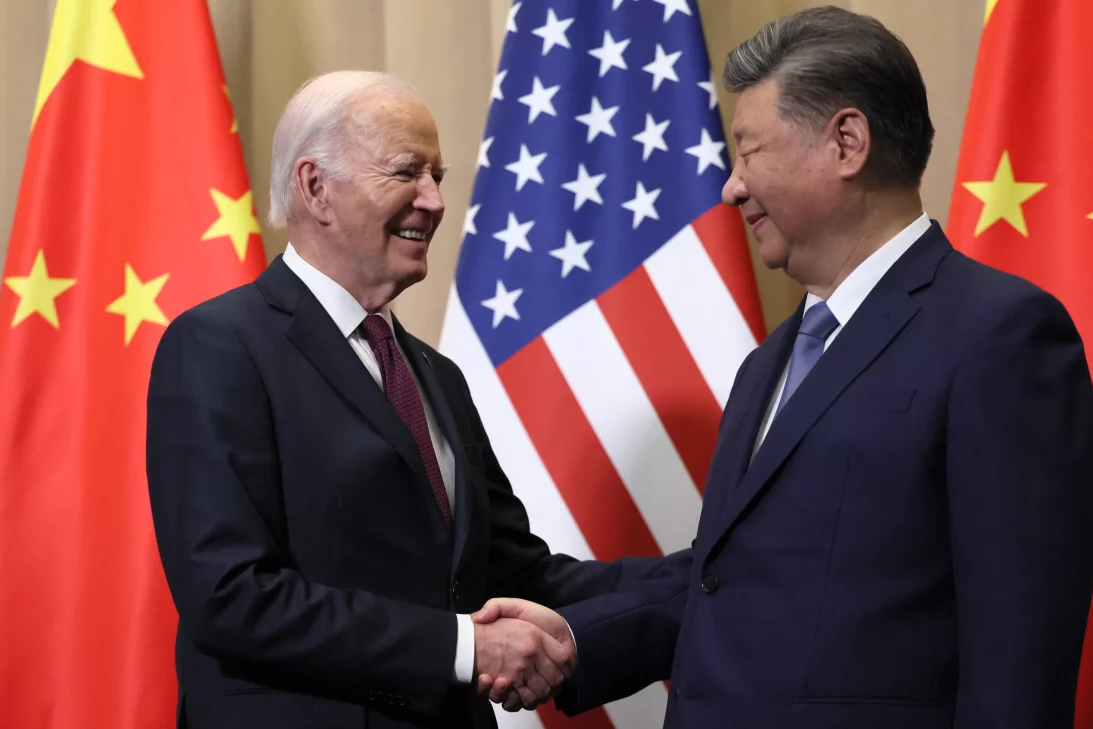
U.S. President Joe Biden shakes hands with Chinese President Xi Jinping on the sidelines of the Asia-Pacific Economic Cooperation (APEC) summit in Lima, Peru on Nov 16.
On November 16 in Lima, Peru, Presidents Joe Biden and Xi Jinping held their last of three in-person meetings during the Biden presidency (they also held several phone and video calls). Dating back to 2011, when they were both vice-presidents, the two have spent about 100 hours together. During the four years of the Biden administration, the U.S.-China relationship has traversed a difficult and, at times, rocky course. But over the past two years the two governments have managed to find some stability through reestablishing some channels of communication and exchanges.
It started off with the hot encounter in frigid Alaska in March 2021 when sparks flew between senior officials in front of the television cameras. As the Biden administration rolled out its China policies during the remainder of 2021 and early 2022, those in China who had expected a “reset” of American China policy under Biden, following Trump 1.0, had to be disappointed because Biden’s approach to China exhibited substantial continuity with Trump’s. Biden reiterated that the relationship was to be guided by “competition” and Biden officials used different adjectives to describe the competition (including stiff, extreme, strategic, assertive, comprehensive, and managed). In May 2022, Secretary of State Antony Blinken unveiled the administration’s full China policy in a speech at George Washington University.
A central part of the Biden China strategy was to work closely with Asian and European states to push back against China in both regions. The administration’s efforts went far towards repairing the strains and dysfunctionality in transatlantic relations that had existed under the Trump administration, and America’s relations with Indo-Pacific allies and countries similarly improved. While Washington’s and Europe’s positions on China are not identical, they may never have been so aligned as by the end of the Biden administration.
During these two years, in conjunction with Congress, the Biden administration also undertook a range of steps to improve America’s competitive position vis-à-vis China. This includes passing landmark legislation such as the CHIPS and Science Act and tightening export controls to restrict high technology from going to China.
However, the first two years of the Bident administration experienced considerable tensions and mutual suspicions. American ambassador to China Nicholas Burns even characterized the relationship as being at “its lowest point” since the ice-breaking Nixon visit to China in 1972. These frictions included the massive military exercises undertaken by China surrounding Taiwan following House of Representatives Speaker Nancy Pelosi’s visit to the island in August 2022. Various other events and actions contributed to the fulsome deterioration of bilateral ties, including China’s unrelenting cyber-attacks on U.S. government and private sector entities.
In an attempt by both sides to put a “floor” beneath the cratering relationship, U.S. National Security Advisor Jake Sullivan and his counterparts State Councilor Yang Jiechi and Wang Yi began a series of discrete in-person meetings in October 2021. This new channel of communication injected important new direct candor at a critical time (which continued through the end of the administration). This was part and parcel of the Biden administration’s shift to a policy of “managed competition.” It also lead to an important in-person presidential meeting with Biden and Xi Jinping in Bali, Indonesia in November 2022.
Unfortunately, the efforts that the two sides agreed to in Bali to try and improve relations were quickly short-circuited by the January-February 2023 “spy balloon incident” and Russia’s ongoing invasion of Ukraine that began a year earlier. Nonetheless, the two sides kept talking via the Sullivan-Wang channel. This channel was broadened to include a handful of ministerial/cabinet level visits between senior commercial officials and in June 2023 with a visit to Beijing by U.S. Secretary of States Antony Blinken and the November 2023 visit by Foreign Minister Wang Yi to Washington. From the U.S. perspective, these exchanges were consummate with the “managed competition” strategy.
The two sides’ improved communications definitely served to stabilize the unstable relationship. They also paved the way for the second in-person leaders’ summit in Woodside, California in November 2023. This summit reestablished military-to-military dialogues, which had been broken off (by the Chinese side) following the August 2022 visit by Speaker Pelosi to Taiwan. It also restarted some other bilateral Working Groups on artificial intelligence, climate change, counter-narcotics, and people-to-people exchanges.
By the time the two presidents met last week in Peru, some stability had been reestablished in the relationship (at least when compared with the very rocky previous three years). From public reports, the most recent leader level meeting was both “candid and constructive.” Both sides reiterated to the other their longstanding concerns, but at least there now exists a reestablished framework for “managing competition.” Only time will tell whether the Trump 2.0 administration maintains, builds on, or jettisons the tenuously more stable relationship that President Biden bequeaths to him.